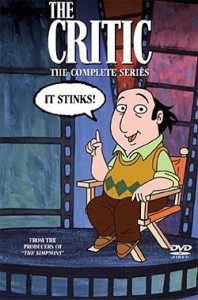Condition Critical
With the proliferation of culture-based websites and a trend toward bite-sized reviews, the professional arts critic may be an endangered species. But there is hope—Internet-based magazines like CBC Arts Online and Television Without Pity are providing a sanctuary for this increasingly scarce brand of journalism
 When a big-budget film about the life of Johnny Cash was released in November, Eye Weekly film reviewer Jason Anderson was disappointed. “As a biopic, Walk the Line is riddled with familiar problems,” he wrote. “Director James Mangold’s movie is based largely on Cash’s own frank memoirs so the issue is not that Mangold whitewashes the story of the Man in Black. Instead, he relies on the hoariest kind of movie vocabulary to tell the tale. From the badly reductive pop psychology that roots our hero’s troubles in a childhood trauma (like Ray Charles, Cash lost a cherished brother at an early age) to the cheeseball montages that summarize career highlights for the hard of thinking, Walk the Line has got it all and a young Elvis (Tyler Hilton) drawling lines like ‘Want some chili fries?'” Anderson gave the film two out of five stars.
When a big-budget film about the life of Johnny Cash was released in November, Eye Weekly film reviewer Jason Anderson was disappointed. “As a biopic, Walk the Line is riddled with familiar problems,” he wrote. “Director James Mangold’s movie is based largely on Cash’s own frank memoirs so the issue is not that Mangold whitewashes the story of the Man in Black. Instead, he relies on the hoariest kind of movie vocabulary to tell the tale. From the badly reductive pop psychology that roots our hero’s troubles in a childhood trauma (like Ray Charles, Cash lost a cherished brother at an early age) to the cheeseball montages that summarize career highlights for the hard of thinking, Walk the Line has got it all and a young Elvis (Tyler Hilton) drawling lines like ‘Want some chili fries?'” Anderson gave the film two out of five stars.
“But,” you said, “Why should I trust the opinion of just one man? He’s probably some tweed-wearing old curmudgeon who thinks movies have been going downhill ever since the old studio system collapsed.”
You cracked open your laptop and visited Rottentomatoes.com, the site that compiles scores from reviews across North America and gives each film an average rating. Walk the Line‘s score stood at 81 per cent.
You went to the film.
• • •
The arts critic traditionally plays one of two roles, according to Anderson, 33, who may have worn tweed patches on his jacket once when he was 17. The first is the consumer guide, who recommends or discourages the purchase of a product based on its commercial viability. But sites like Rottentomatoes.com and Metacritic.com, with their quantified, number-based reviews, along with ubiquitous culture blogs and message boards, may have rendered the professional arts critic obsolete. “You get arts journalists together these days,” says Doug McLennan, editor of ArtsJournal.com, in the Los Angeles Times, “and it’s what they talk about: their declining influence.”
Anderson doubts whether critics ever had much influence over popular taste in the first place. “There is a tendency to overrate a critic’s power to put bums in seats,” Anderson says. He cites New York punk foursome The Ramones as a classic example of the critically adored, but commercially unsuccessful rock band.
The second role an arts critic performs, the one that has a greater (if narrower) impact, is that of the cultural commentator. This longer, deeper form of criticism dissects and deconstructs the arts for readers, placing works in their broader cultural context. While usually associated with the high arts like theatre, ballet and classical music, writers like James Agee, Andrew Sarris and Pauline Kael brought the same approach to pop culture like rock ‘n’ roll and movies in the 1950s and 1960s.
“I don’t see us as a big herd of dinosaurs walking over a cliff,” says Toronto Star movie critic Peter Howell. The traditional arts critic, whose studied-yet-passionate opinions are backed by an extensive knowledge of the history and current trends of the art form, is more important than ever, he says. Anyone who can make some sense of the glut of movies, music, television shows, books and media surrounding us is doing a great service to readers.
But as Chris Jones, writing in the Chicago Tribune, points out, there are many barriers for journalists looking to do this kind of serious arts journalism in the mainstream media: “Penny-pinching publishers. Readers with short attention spans and diminishing interest in serious cultural criticism. Obfuscating TV networks and Hollywood studios. Actors with short fuses and long tentacles of clout…. Web-based reviews of everything from hotels to books.” But, he adds, “there still are publications that showcase reviews and readers who seek them out, read them, think about them and even act upon them.”
And, as it turns out, some of these publications come from the same place purported to be one of serious criticism’s principal assassins: the Internet.
• • •
“Our tagline should read ‘Reducing workplace productivity since 1999,'” says Sarah Bunting, co-editor-in-chief of Television Without Pity (TWoP), a website dedicated to lengthy recaps of the best and worst offerings on the idiot box. Bunting, 32, is talking from her New York apartment, where she spends most of her days editing recaps and monitoring the site’s heavily populated message boards. And, of course, watching TV.
TWoP, which was founded as MightyBigTv in 1999, receives over one million unique hits and over 50 million page views per month, mostly from female readers who are almost exclusively in the 18 to 34 demographic. The advertising revenue generated by TWoP’s licensing deal with Yahoo.com provides a steady income for both Bunting and her Toronto-based partner, Tara Ariano, though both maintain other websites and write freelance. They even manage to pay writers, but won’t disclose the rate.
The site currently monitors 27 TV shows, covering everything from lowest common denominator “reality” fare like Are You Hot? and The Simple Life to hoity-toity critical faves like Deadwood and The West Wing. Each episode is recapped, scene-by-scene, by writers with monikers like Miss Alli, M. Giant, Sars (Bunting), and Wing Chun (Ariano). “We don’t really review TV,” Bunting says, “we kind of explicate it.”
TWoP’s recaps are characterized by an acidic, irreverent tone, laced with cultural references of both the pop and academic variety. But while many who visit the site come looking for a laugh, they also get a hefty dose of cultural analysis and arts criticism. “We take the medium seriously,” says Bunting. “We come from a place of expecting TV to stand up to standards of artistic quality.”
TWoP’s recaps often run up to 20 pages. The length allows writers to delve deeply into the shows they’re writing about, with plenty of room for critical analysis of character, script, story arc and consistency.
Writing about the troubled fourth season of The Sopranos, recapper Aaron wrote: “Seriously – the hell? Meadow’s all depressed about Jackie Jr., there’s a big blow, she goes back to school and grows a social conscience, then she basically disappears except for a couple of drive-bys mid-season, and now… she’s back? With a boyfriend? And that’s it? That’s all we get? The show keeps doing that to us – giving characters big showcase episodes, then shuffling them to the bottom of the deck for weeks at a time – and I don’t think Season Four is nearly the bust a lot of critics do, but it’s got a couple of problems, and if I had to point to the biggest one, I’d point to that. The Sopranos has too many characters taking up too much airtime, and a lot of them just don’t merit the attention.”
Stuart Berman, senior editor and music critic at Eye Weekly, says space limitations and concerns about readers’ “short-attention spans” have led print publications toward smaller, bite-sized reviews. He credits online publications like the influential music site Pitchforkmedia.com for giving its writers the room to expound. “Some people see them as snobs,” Berman says, “but they’ll take 1,000 words to dissect an album, and that’s rare.”
Greig Dymond, senior producer of CBC Arts Online, doesn’t allow his writers to wax poetically about the “faces of Coltrane” for 12 pages à la Lester Bangs. Unlike newspapers and print magazines, online magazines have to be concerned about the dreaded “Back” button, the temptation to use Google while perusing stories, and the fact that reading off a computer can be hard on the eyes.
But they do wax. With stories like Andre Mayer’s “Hit the Road, Jaxx: Why Dance Music Doesn’t Move America,” Katrina Onstad’s “Girl Trouble: Fear and Self-loathing in Chick-lit,” and Matthew McKinnon’s “Kicking Up Dust: The Remarkable Hip-hop Odyssey of Toronto’s K’naan” appearing on the public broadcaster’s website, CBC Arts Online is providing the kind of in-depth arts coverage the Internet is supposedly killing.
Launched in January 2005 and averaging 3.3 million page views per month, Dymond and his team are making good on their promise “to explore Canada and the world through the fascinating prism of arts, media and entertainment. The culture surrounding us isn’t just about diversion – we think it’s more important than that.”
Take Onstad’s review of the Vin Diesel comedy, The Pacifier, written last March, which was entitled, “Fear of Diapers: The Male Mommy Movie.” She doesn’t merely recap the film and tell readers whether or not to spend 12 bucks on it (though it’s clear she feels they shouldn’t). Instead, she uses the film as a vehicle for a 1,700-word essay on masculinity and parenting, name-checking Jean-Jacques Rousseau, Neil Postman and Ben Affleck along the way. “The decline of the Atticus Finch-noble dad archetype in favour of the buffoon dad isn’t just about poking fun at that last pokeable social group, men,” she writes, “but it’s also about the rise of the child. These movies venerate youth as much as they mock fatherhood, and in doing so, tell moms to stop bitching; this parenting stuff’s a breeze.”
The mainstream press reaction to the Internet has been just that: reactionary. In the same way that the advent of televised sports did not kill the newspaper sports reporter, the proliferation of opinion on the Internet will not kill the professional arts critic. As TWoP and CBC Arts Online demonstrate, we’re seeing the beginning of what may well be a golden age of cultural debate.
“The Internet isn’t even close to its potential yet,” says Howell. “We’re still at the T-model Ford stage.”











